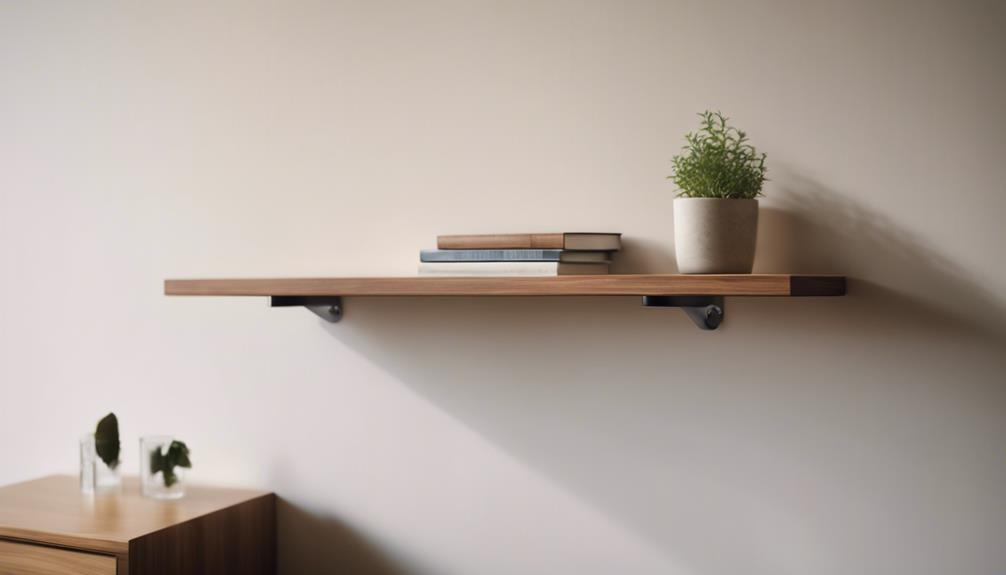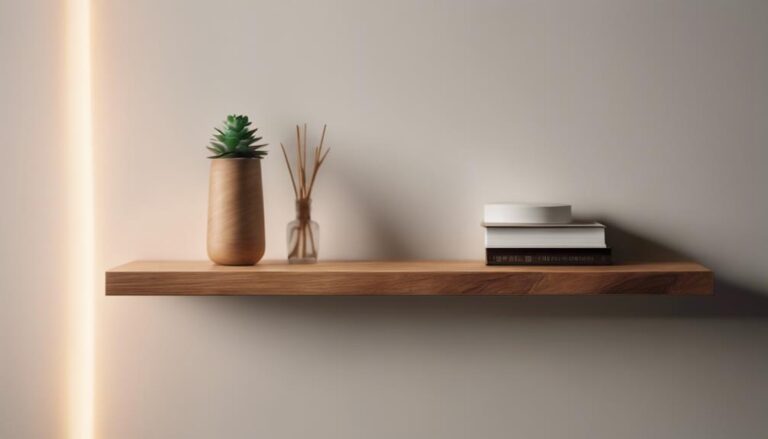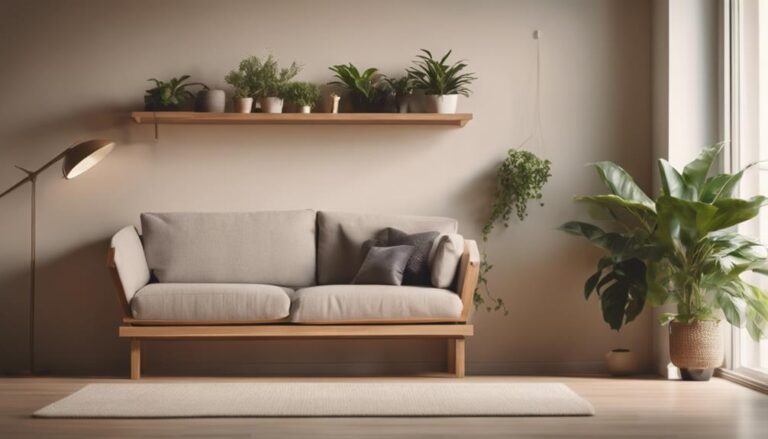Strategies for Location Selection When Installing a Floating Wood Shelf

When setting up a floating wood shelf, it's essential to take into account the type of wall material you're working with. Different materials require specific mounting hardware and techniques to ensure a secure installation. Stud placement is a key factor to consider as it provides the necessary support for the shelf. By identifying where the studs are located, you can ensure that your shelf is properly supported and able to bear weight effectively.
Determining the anchor point requirements is crucial for ensuring the stability and weight-bearing capacity of the floating wood shelf. This involves understanding the weight capacity of the shelf and choosing the appropriate anchor points to support it. Measuring for the desired shelf length is also important as it determines the shelf's capacity, purpose, and how it fits into the overall decor of the room.
It's crucial to accurately evaluate the weight capacity and placement of the floating wood shelf to guarantee its safety and functionality. By strategically positioning the shelf near wall studs, you can maximize its strength and prevent any potential sagging or structural issues. Balancing aesthetics and functionality through corner placement or strategic positioning can create a visually appealing and practical solution for your space.
By carefully considering these factors and utilizing proper techniques, you can ensure a successful installation of your floating wood shelf that is both secure and visually pleasing.
Key Takeaways
When setting up a floating wood shelf, it is crucial to consider the type of wall material to determine the most suitable mounting hardware and techniques that can support the shelf's weight effectively. Different wall materials, such as drywall or concrete, require specific anchoring methods to ensure stability and durability over time.
Locating wall studs is essential in ensuring a secure attachment for the floating shelf. By attaching the shelf to studs, you can evenly distribute the weight of the shelf and prevent it from sagging or coming loose. This method provides a reliable support system for the shelf, especially if you plan on displaying heavy items.
Assessing the anchor point requirements is another critical step in the location selection process. The weight of the shelf and the wall material will determine the type of anchors needed to maintain stability. For heavier shelves, consider using toggle bolts or anchors that can securely hold the weight without damaging the wall.
Measuring the available wall space is necessary to determine the appropriate shelf length and placement for a customized fit. Taking accurate measurements will ensure that the shelf fits perfectly in the chosen location and complements the overall aesthetic of the room.
Considering the weight capacity of the shelf location is also essential for a safe installation. Make sure that the chosen location can support the weight of the shelf and the items you plan to display. Overloading a shelf can lead to structural issues and compromise the integrity of the installation.
By following these location selection strategies, you can ensure a successful and secure installation of a floating wood shelf in your home.
Importance of Wall Material Consideration
Choosing the right wall material is crucial when installing a floating wood shelf. It directly influences the type of mounting hardware and techniques needed to ensure a secure and durable setup. By considering the weight capacity of the wall, we can avoid any safety risks or potential damage in the future.
Different materials like drywall, plaster, brick, or concrete have varying load-bearing capabilities, so understanding the wall composition is essential.
The wall material also dictates the drilling process and the specific anchors or screws required for installation. For instance, drilling into concrete necessitates masonry bits and heavy-duty anchors, while drywall calls for specialized wall anchors. Being aware of these differences allows us to choose the right tools and methods, preventing any costly errors or unappealing installations.
Proper evaluation of the wall composition is key to a successful floating wood shelf setup. By taking the time to assess the material, we can develop a customized installation strategy that enhances the shelf's functionality and longevity.
Understanding Stud Placement
Let's kick off by pinpointing the wall studs, a crucial initial step in installing floating wood shelves. We'll rely on a stud finder to precisely locate them behind the wall.
After identifying the stud placement, we'll measure the distance between them to ensure that our shelves receive adequate support.
Identify Wall Studs
Finding wall studs is crucial before installing a floating wood shelf, as they provide essential support. Using a reliable stud finder will help pinpoint the exact locations of the studs on your wall, ensuring a secure attachment for your shelf.
Knowing where the studs are located is key to determining the ideal placement for your floating wood shelf. Distributing the weight evenly across multiple studs can prevent any potential issues like sagging or instability in the future. Take the time to map out the stud locations carefully to guide your shelf positioning.
Securing the shelf to the wall studs properly is essential for a strong and durable installation. This step significantly impacts the overall stability and weight-bearing capacity of your floating wood shelf. By following the correct anchoring process, you'll have a functional and reliable shelf that will last for years to come.
Measure Stud Spacing
When preparing to install a floating wood shelf, it is crucial to measure the spacing between wall studs. Most homes have studs spaced between 16 and 24 inches apart, which informs the placement and number of brackets required for a secure mount. To accurately locate the studs behind the wall, a dependable stud finder is essential to ensure the shelf's stability and weight distribution.
The table below outlines the recommended bracket placement based on different stud spacings:
| Stud Spacing | Bracket Placement |
|---|---|
| 16 inches | 3 brackets |
| 18 inches | 3 brackets |
| 20 inches | 4 brackets |
| 22 inches | 4 brackets |
| 24 inches | 4 brackets |
Determining Anchor Point Requirements
Determining the correct number and placement of anchor points is crucial for ensuring that your floating wood shelf is stable and can bear the weight of items placed on it. To determine the necessary anchor points, consider the weight capacity of the shelf and the weight of the items it will hold.
It's important to evenly space the anchor points along the length of the shelf to provide balanced support. Heavier shelves or items will require more anchor points to effectively distribute the weight. The type of wall material and the locations of studs will also impact where the anchor points should be placed.
We recommend seeking advice from a professional or using a stud finder to locate secure anchor points that can safely and securely support the shelf.
Measuring for Desired Shelf Length
When installing a floating wood shelf, the initial and critical step is to carefully measure the wall space where it will be placed. This ensures a custom fit that aligns perfectly with your desired length. Factors to consider include the shelf's purpose, the weight capacity of the brackets, and how well it complements the room's decor and furniture.
To determine the maximum shelf length, measure the width of the wall where the shelf will be installed. This measurement will guide you in selecting the appropriate size for your floating wood shelf, ensuring a seamless and professional installation that enhances both functionality and visual appeal.
Consider the intended use of the shelf to inform the desired length. Whether it's for decorative items, books, or other objects, the shelf should be tailored to meet your specific needs and enhance the overall aesthetics of the room.
Make sure to assess the weight-bearing capacity of the shelf brackets to ensure structural integrity and safety. By matching the shelf length to the brackets' capacity, you can prevent any potential issues such as sagging or instability.
Lastly, take into account the existing decor and furniture in the room to ensure the shelf harmonizes with the overall design scheme. A well-integrated floating wood shelf can elevate the space and create a cohesive look that ties everything together seamlessly.
Evaluating Weight Capacity Needs
When setting up a floating wood shelf, it's crucial to assess the weight capacity accurately to ensure safety and avoid any potential damage. This involves calculating the total weight of the shelf itself and the items you intend to place on it. By referring to the manufacturer's specifications, you can determine the maximum load the shelf can safely handle. This assessment is essential in guaranteeing a secure and stable installation for your floating wood shelf.
Assess Shelf Load Limit
When determining the load limit of a floating wood shelf, it's crucial to consider the weight capacity range, which can vary from 25 pounds to a substantial 350 pounds. This wide range highlights the importance of carefully assessing the items you intend to place on the shelf and their total weight.
By referring to the manufacturer's guidelines, you can establish the maximum load the shelf can safely bear, thereby avoiding any potential damage or safety risks.
Equally important is selecting a location that can support the expected weight of the shelf and its contents. Prioritize areas with adequate structural reinforcement, such as wall studs, to ensure the shelf remains stable and securely anchored.
This meticulous attention to detail during the location selection process will enhance the overall success and durability of the floating wood shelf installation. By thoroughly evaluating the shelf's load limit and choosing an appropriate placement, you can confidently create an attractive and practical storage solution.
Consider Item Weights
When setting up a floating wood shelf, it's crucial to consider the weight of each item you plan to store on it. Exceeding the manufacturer's recommended weight capacity can compromise the shelf's structural integrity and pose a safety risk. By carefully evaluating the weight distribution of your objects, you can determine the best placement to avoid overloading.
The weight capacity of the floating wood shelf plays a vital role in this decision-making process. Balancing your storage needs with the shelf's load limit is essential to ensure a secure installation. Select a location that can support the necessary weight while maintaining the shelf's integrity.
Assessing the structural integrity of the wall is equally important, as the shelf's weight-bearing capabilities depend on the wall's ability to support the items. Only by meticulously considering item weights can you confidently install a floating wood shelf that meets your storage requirements without compromising safety.
Determine Placement Capacity
When choosing the right spot for your floating wood shelf, it's crucial to assess its weight capacity to ensure a safe and steady installation. To guarantee stability, we need to carefully analyze how the weight is distributed across the shelf and ensure it can securely hold the items you plan to place on it. Checking the manufacturer's recommendations on weight limits and installation instructions is essential for finding the perfect location.
Considering the placement of wall studs or other support structures is vital for anchoring the floating wood shelf properly and distributing the weight effectively. This strategic positioning not only meets your weight capacity requirements but also enhances the overall aesthetics and functionality of the space.
Preparing for a Secure Installation
When securing the floating wood shelf to the wall studs, it's crucial to ensure its stability and weight-bearing capacity. Using a stud finder is the first step in accurately locating the solid wood supports hidden within the drywall. This essential task guarantees that the shelf will be mounted securely, able to support the intended items without any risk of detachment.
After locating the wall studs, the next step is to carefully measure the depth and thickness of the shelf. This measurement ensures that the shelf fits seamlessly into the chosen location, creating a harmonious blend of form and function for a professional, polished look in the room.
It is also important to consider the visibility and accessibility of the shelf's placement. Is the shelf easy to reach and use? Does it enhance the overall aesthetics of the room? These factors play a crucial role in planning the installation of your floating shelf and ensuring that it not only serves its purpose but also adds to the visual appeal of the space.
Choosing Appropriate Hardware
When picking out the right hardware for a floating wood shelf, it's crucial to prioritize durability and weight capacity. Opt for heavy-duty mounting hardware specifically designed for wood shelves to ensure proper support. Make sure the hardware can handle the weight of the items you plan to place on the shelf. Also, consider the thickness and material of the wood shelf to ensure compatibility with the chosen hardware.
For a secure installation, the hardware should allow easy mounting into wall studs. Look for options that provide clear installation instructions to help you through the process. This will ensure a strong and polished final look.
Maximizing Shelf Strength
To ensure maximum strength for our floating wood shelf, it's crucial to strategically position it near wall studs for increased support and weight capacity. Avoiding installation over doorways or windows is essential to prevent any potential structural issues. Optimal shelf strength can be achieved by selecting locations on load-bearing walls or areas with solid support.
Choosing corners or alcoves for shelf placement can provide added stability and minimize stress on the shelf. Additionally, installing the shelf on load-bearing walls offers ideal strength and support, ensuring long-term durability. Positioning the shelf near wall studs can also significantly increase its weight capacity, making it suitable for displaying decor, storing books, or holding heavier items.
Considering the intended use of the shelf is key in determining the best location for long-lasting strength. By evaluating factors such as the weight of items to be placed on the shelf and the overall purpose of the installation, we can ensure that our floating wood shelf remains secure and sturdy for years to come.
Ensuring Proper Shelf Support
Finding the wall studs is crucial for ensuring our floating wood shelf has the robust support it needs. To accurately locate these key structural elements, a reliable stud finder is essential. This tool will help us pinpoint the exact placement of the studs in the wall, allowing us to install the shelf's mounting hardware directly into them. This method maximizes the weight capacity of the shelf and ensures a secure installation.
When determining the ideal location for the shelf, it's important to consider the total weight that will be placed on the wall by the shelf and its contents. By anchoring the shelf into the studs, we can evenly distribute this weight, preventing any potential sagging or structural issues in the future. It's also wise to avoid areas near heat sources or high humidity to maintain the shelf's integrity and prevent warping over time.
Careful consideration of placement is essential for both the functionality and aesthetics of the shelf. Striking a balance between accessibility and visual impact is key when selecting the location. By strategically planning the shelf's support, we can ensure it remains a stable and enduring feature in the room.
Considerations for Corner Placement
When installing a floating wood shelf, consider placing it in a corner to maximize space utilization. This location not only adds a stylish touch but also offers practical storage and display options. To ensure a perfect fit, carefully measure the height and depth of the shelf for a snug installation.
By strategically positioning the shelf in a corner, you can make the most of every inch of your room without compromising valuable floor space.
Corner-mounted floating wood shelves are versatile solutions that can enhance the aesthetics of a room while providing additional storage capacity. Whether you want to showcase decorative items or improve organization, a corner placement can meet your needs effectively.
Embracing this alternative location can help create a visually appealing and functional space in your home.
Balancing Aesthetics and Functionality
When setting up a floating wood shelf, it's essential to find the right balance between its visual appeal and practical use to achieve a cohesive and pleasing look in the room. By carefully considering the room's function and traffic patterns, we can choose a spot that not only showcases the shelf's natural beauty but also enhances the overall design.
Firstly, take a look at the wall space to see how much natural light it receives and ensure the shelf's placement adds to the room's visual symmetry. This helps create a sense of harmony and balance in the space.
Next, consider the weight capacity of both the wall and the shelf brackets. It's crucial to choose a secure location that can support the shelf without compromising its stability. This ensures that the shelf stays in place and functions as intended.
Lastly, think about the accessibility of the items you plan to place on the shelf. Position it in a way that makes it easy to reach items while seamlessly blending with the room's overall functionality. This way, you not only enhance the room's aesthetics but also make practical use of the shelf.
Frequently Asked Questions
How Do You Know Where to Put Floating Shelves?
To determine the perfect placement for our floating wood shelves, we first measure the ideal shelf height based on the room's function and the items to be displayed. This ensures that the shelves are easily accessible and visually appealing. Next, we evaluate the sturdiness of the walls to ensure they can support the weight of the shelves and items placed on them.
Considering the layout of the room is crucial in finding the right spot for floating shelves. We take into account the furniture arrangement and traffic flow to ensure the shelves do not obstruct movement or clash with other design elements. Achieving visual balance is also essential, as we aim to create a harmonious and aesthetically pleasing display.
In addition, we consider lighting effects when determining the location of floating shelves. Placing them near natural light sources or incorporating artificial lighting can enhance the overall look and highlight the items on display. Optimizing shelf spacing is another key factor, as we strive to create a functional and attractive arrangement that maximizes storage and visual impact.
Safety is paramount in the installation of floating shelves, so we address any concerns related to weight capacity, anchoring, and potential hazards. By following these steps and taking all relevant factors into consideration, we can confidently select the perfect spot for our floating wood shelves.
What Do I Need to Know Before Installing Floating Shelves?
When setting up floating wood shelves, it's important to consider the guidelines for shelf placement, weight capacity, materials used, secure mounting, ideal dimensions, and aesthetics. By following these factors, we can create a modern, practical, and visually appealing display that complements our space.
To begin, think about where you want to place your floating wood shelves. Consider the room layout, wall space, and how the shelves will interact with other elements in the room. By selecting an optimal location, you can enhance the overall look and functionality of the space.
Next, ensure that the materials used for the shelves are sturdy and durable. Wood is a popular choice for floating shelves due to its natural beauty and strength. Select a high-quality wood that can support the weight of the items you plan to display.
When it comes to mounting the shelves, make sure to securely attach them to the wall. Use appropriate mounting hardware and follow the manufacturer's instructions for installation. This will help prevent accidents and ensure the stability of the shelves.
Consider the dimensions of the shelves in relation to the space available. Choose sizes that fit well in the designated area and provide enough surface area for your items. This will help create a balanced and harmonious look in the room.
Lastly, pay attention to the aesthetics of the shelves. Consider the design, finish, and style that will complement the existing decor in your space. By selecting shelves that enhance the overall aesthetic, you can create a cohesive and visually appealing display.
What Is the Best Placement for a Shelf?
The pursuit of the perfect floating wood shelf is a noble one. We must carefully consider the placement, taking into account not just aesthetics but also functionality. The shelf should be positioned strategically, utilizing the principles of balance and symmetry to create a harmonious space.
When selecting the location for your floating wood shelf, it is important to consider the overall layout of the room. Take note of existing furniture and fixtures, ensuring that the shelf complements rather than competes with the surrounding elements. Additionally, consider the natural lighting in the room and how it will interact with the shelf at different times of the day.
In terms of height, there is a fine balance to strike. While placing the shelf at eye level may seem too ordinary, suspending it too high can make it inaccessible and impractical. Aim for a height that is both visually appealing and functional, allowing for easy access to the items on display.
For a truly impactful look, consider installing the floating wood shelf above a focal point in the room, such as a fireplace or a piece of artwork. This will draw the eye upwards and create a sense of height and drama in the space. Additionally, consider the weight-bearing capacity of the wall where you plan to install the shelf, ensuring that it can support the weight of the shelf and any items you wish to display.
What Tool Can You Use to Identify a Secure Location for a Shelf?
To identify a secure location for a floating wood shelf installation, it is essential to utilize a stud finder. This tool helps assess the thickness of the wall and locate the studs for optimal support. By planning the layout of the shelves based on the stud findings, we can ensure they are securely mounted.
In addition to using a stud finder, it is crucial to consider weight distribution when determining the placement of the shelves. Properly distributing the weight across the studs will help prevent any issues with the shelves becoming unstable over time. This is especially important for floating shelves, as they rely on secure mounting to maintain their position on the wall.
When preparing the surface for mounting the shelves, leveling tools should be used to ensure the shelves are straight and properly aligned. This not only enhances the aesthetic appeal of the shelves but also contributes to their stability. By taking the time to properly prepare the surface and mount the shelves securely, we can create a functional and innovative design that enhances the space.
Considering lighting when planning the location of the shelves can also add a unique touch to the design. By strategically placing the shelves in relation to lighting fixtures, we can create a visually appealing display that highlights both the shelves and the items displayed on them. This attention to detail can elevate the overall look of the space and make the floating wood shelf installation truly stand out.
Conclusion
When installing a floating wood shelf, it's essential to carefully assess the wall material, locate the studs, determine the necessary anchors, decide on the desired length, consider the weight capacity, and choose the appropriate shelf support. By carefully evaluating these key elements, you can create a visually striking and incredibly sturdy floating shelf that will enhance your space and impress all who see it.
When selecting the location for your floating wood shelf, it's crucial to take into account the type of wall material you're working with. Different materials, such as drywall, plaster, or brick, may require specific anchor types and installation methods to ensure the shelf is securely mounted. Stud placement is also vital for providing the necessary support for the weight of the shelf and its contents.
In addition to the wall material and stud placement, consider the weight capacity of the shelf and the items you plan to display on it. It's important to choose a location that can support the weight without compromising the integrity of the wall or the shelf itself.
Furthermore, think about the desired length of the shelf and how it will fit within the overall design of the room. A well-placed floating shelf can't only provide functional storage but also serve as a decorative accent that complements the aesthetic of the space.
By carefully considering these factors and taking the time to plan out the installation, you can create a floating wood shelf that not only looks impressive but also functions flawlessly. With the right location selection and attention to detail, your floating shelf will be a standout feature in your home that adds both style and practicality.





